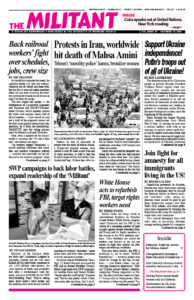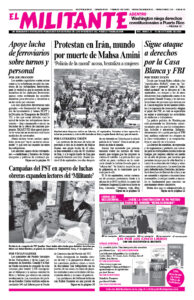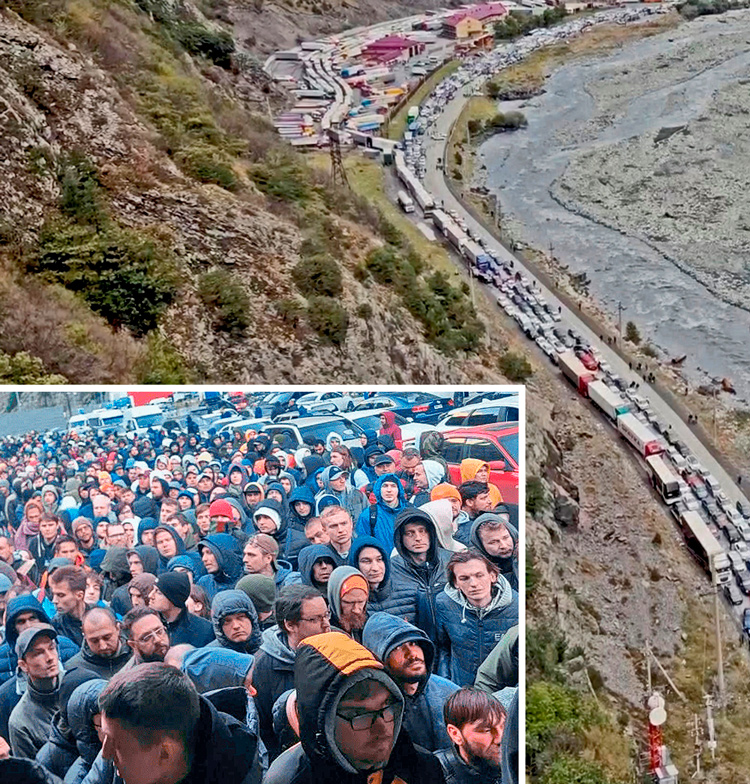The determination of the Ukrainian people to prevent Russian President Vladimir Putin’s regime from conquering their country was decisive in a series of battlefield victories won earlier this month in Kharkiv province. Putin’s response is to call up hundreds of thousands of new troops and threaten a nuclear war, leading to protests by thousands across Russia, the most widespread actions since the beginning of the invasion.
Putin decreed the largest Russian military mobilization since World War II Sept. 21, aiming to rush over a million soldiers, with little or no training, to replace severe battle losses and to relieve exhausted front line forces. He also announced rigged referenda carried out at rifle point in four occupied areas of Ukraine, providing a pretext for claiming to incorporate them into Russia.
Chanting “No to war!” “No mobilization!” and “Send Putin to the trenches!” thousands protested in scores of cities and towns across Russia, from St. Petersburg in the west to Ulan-Ude in the east.
More than 1,300 people were arrested in Moscow and 1,000 more in other parts of the country. Some young men have been issued draft notices while they were detained for joining protests.
“Coming out now is very dangerous, otherwise there would be many more people,” Vasily Fedorov, a student at a protest in Moscow, told France24. As more Russians learn the truth about the Kremlin’s invasion, “they will come on to the street, despite the fear,” said Alina Skvortsova, 20, who was also at the action.
Putin signed a new bill Sept. 24 doubling the punishment to 10 years in prison for troops who surrender, desert or refuse to fight. Ukrainian President Volodymyr Zelensky promised no Russian prisoners of war held in Ukraine would be returned to Russia against their will.
After Putin’s Sept. 21 decree, tens of thousands of fighting-age men fled Russia by plane, bus or car. Long vehicle lines formed at border points with Finland, Georgia, Kazakhstan and Mongolia.
Protests in Russia over call-up
“Why are you taking our children?” shouted a group of women demonstrating Sept. 25 in Makhachkala, in Dagestan, a majority-Muslim region in southern Russia. “Who was attacked?” they chanted, “Russia has attacked Ukraine! Stop the war!” Over 300 soldiers from the region have died in the conflict, 10 times more than from Moscow. There are similar disproportionate numbers of deaths in other parts of Russia that are home to oppressed nationalities.
Police also assaulted protesters with stun guns and batons, detaining over 100. Angry residents blocked a federal highway in the region near Endirey that day, refusing to move as police fired warning shots.
In Yakutia near the Arctic Circle, 47 of the 300 people living in the village were called up, removing a majority of working men from the village — reindeer herders, hunters and fishermen.
In early September Russian forces were routed by the Ukrainian army’s rapid advance in the northeast around Kharkiv. From their new foothold, Kyiv’s forces have put Russian positions along the line under pressure. In the south, Kyiv’s forces are making slow advances against dug-in Russian units, aiming to liberate Kherson.
Resistance to rigged polls
Parts of Kherson make up one of four occupied areas of Ukraine, along with parts of Donetsk and Luhansk, as well as Zaporizhzhia in the south, where Moscow staged sham referenda on joining the Russian Federation Sept. 23-27. Putin warns that any further Ukrainian counteroffensive into those areas will be treated as a direct attack on Russia. Moscow will respond, he threatens, with all its military might, including a thinly veiled threat to use nuclear weapons.
Despite this, there was resistance to the rigged poll.
More than 50 people rallied Sept. 23 in Snihurivka, an occupied city in the Mykolaiv region, calling for a boycott of the vote. Snihurivka has always been part of Ukraine, they said.
In a sharp break with Moscow, the government of Kazakhstan Sept. 26 refused to recognize the fake referenda in the Russian-occupied areas of Ukraine. It cited the need to recognize “the territorial integrity of states, their sovereign equality.” This shows how Putin’s war has accelerated efforts by this and other Central Asian countries — former Soviet republics — to get out from under Moscow’s domineering role.
Working people are the backbone of the resistance to Moscow’s invasion, volunteering for the Ukrainian armed forces or territorial defense units and aid networks. But they also confront attacks from Zelensky’s capitalist government, which has banned strikes and protests and enforced anti-labor laws long sought by the bosses. In plants that are still working, bosses have forced wage cuts of up to 50% while inflation has surged to over 20%. Unemployment has tripled during the war to 35%.
“Wars are won or lost by the actions of different classes,” John Studer, editor of the Militant, told a Militant Labor Forum in New York Sept. 23. “We know that from the experience of World War II and Vietnam. What will be decisive in ending this war is the fraternization, solidarity and unity of workers in Ukraine and Russia.”
“Out of today’s conflicts, new wars are being prepared that can lead to a world war with the potential for nuclear catastrophe,” he said. “The stakes are enormous for the working class. Workers and farmers in Cuba showed what is possible when they made a socialist revolution taking political power into their own hands.”


